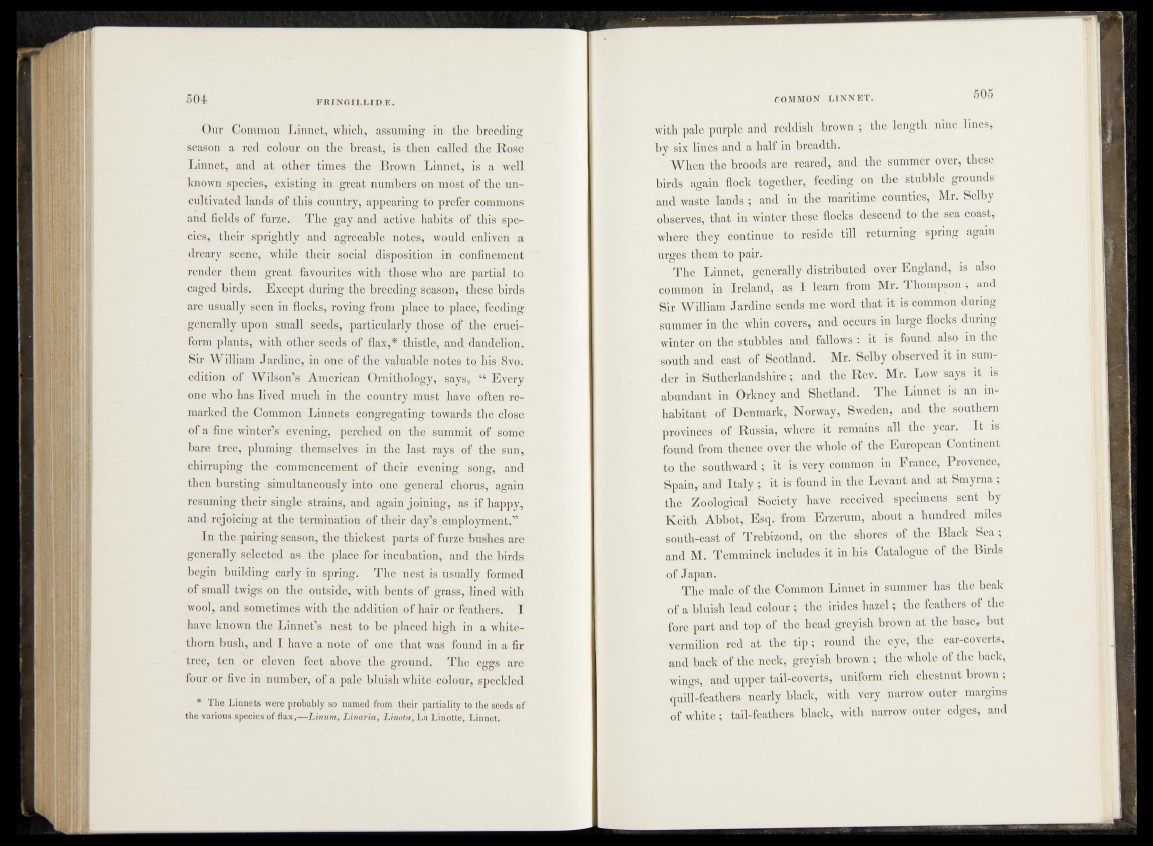
Our Common Linnet, which, assuming in the breeding
season a red colour on the breast, is then called the Rose
Linnet, and at other times the Brown Linnet, is a well
known species, existing in great numbers on most of the uncultivated
lands of this country, appearing to prefer commons
and fields of furze. The gay and active habits of this species,
their sprightly and agreeable notes, would enliven a
dreary scene, while their social disposition in confinement
render them great favourites with those who are partial to
caged birds. Except during the breeding season, these birds
are usually seen in flocks, roving from place to place, feeding
generally upon small seeds, particularly those of the cruciform
plants, with other seeds of flax,* thistle, and dandelion.
Sir Will iam Jardine, in one of the valuable notes to his 8vo.
edition of Wilson’s American Ornithology, says, “ Every
one who has lived much in the country must have often remarked
the Common Linnets congregating towards the close
of a fine winter’s evening, perched on the summit of some
bare tree, pluming themselves in the last rays of the sun,
chirruping the commencement of their evening song, and
then bursting simultaneously into one general chorus, again
resuming their single strains, and again joining, as if happy,
and rejoicing at the termination of their day’s ,employment.”
In the pairing season, the thickest parts of furze bushes are
generally selected as the place for incubation, and the birds
begin building early in spring. The nest is usually formed
of small twigs on the outside, with bents of grass, lined with
wool, and sometimes with the addition of hair or feathers. I
have known the Linnet’s nest to be placed high in a whitethorn
bush, and I have a note of one that was found in a fir
tree, ten or eleven feet above the ground. The eggs are
four or five in number, of a pale bluish white colour, speckled
* The Linnets were probably so named from their partiality to the seeds of
the various species of flax,—Linum, Linaria, Linota, La Linotte, Linnet.
with pale purple and reddish brown ; the length nine lines,
by six lines and a half in breadth.
When the broods are reared, and the summer over, these
birds again flock together, feeding on the stubble grounds
and waste lands ; and in the maritime counties, Mr. Selby
observes, that in winter these flocks descend to the sea coast,
where they continue to reside till returning spring again
urges them to pair.
The Linnet, generally distributed over England, is also
common in Ireland, as I learn from Mr. Thompson ; and
Sir William Jardine sends me word that it is common during
summer in the whin covers, and occurs in large flocks during
winter on the stubbles and fallows : it is found also in the
south and east of Scotland. Mr. Selby observed it in sum-
der in Sutherlandshireand the Rev. Mr. Low says it is
abundant in Orkney and Shetland. The Linnet is an inhabitant
of Denmark, Norway, Sweden, and the southern
provinces of Russia, where it remains all the year. It is
found from thence over the whole of the European Continent
to the southward ; it is very common in France, Provence,
Spain, and Italy ; it is found in the Levant and at Smyrna ;
the Zoological Society have received specimens sent by
Keith Abbot, Esq. from Erzerum, about a hundred miles
south-east of Trebizond, on the shores of the Black Sea ;
and M. Temminck includes it in his Catalogue of the Birds
of Japan.
The male of the Common Linnet in summer has the beak
of a bluish lead colour ; the irides hazel; the feathers of the
fore part and top of the head greyish brown at the base, but
vermilion red at the tip; round the eye, the ear-coverts,
and back of the neck, greyish brown ; the whole of the back,
wings, and upper tail-coverts, uniform rich chestnut brown ;
quill-feathers nearly black, with very narrow outer margins
of white; tail-feathers black, with narrow outer edges, and